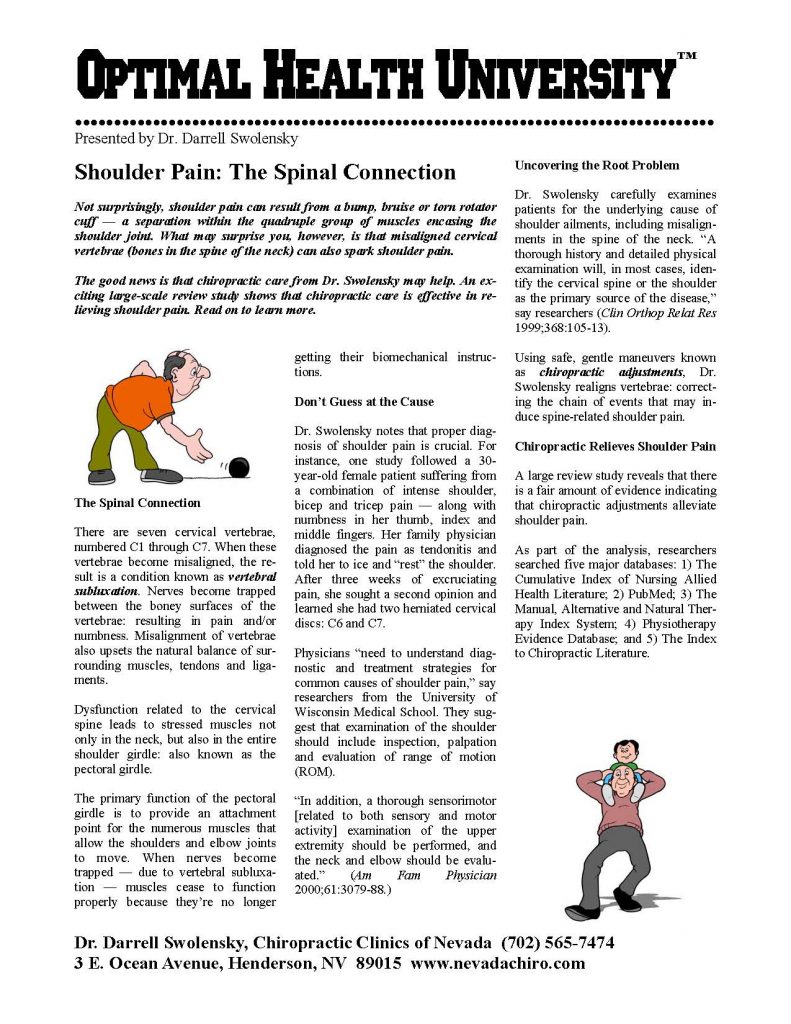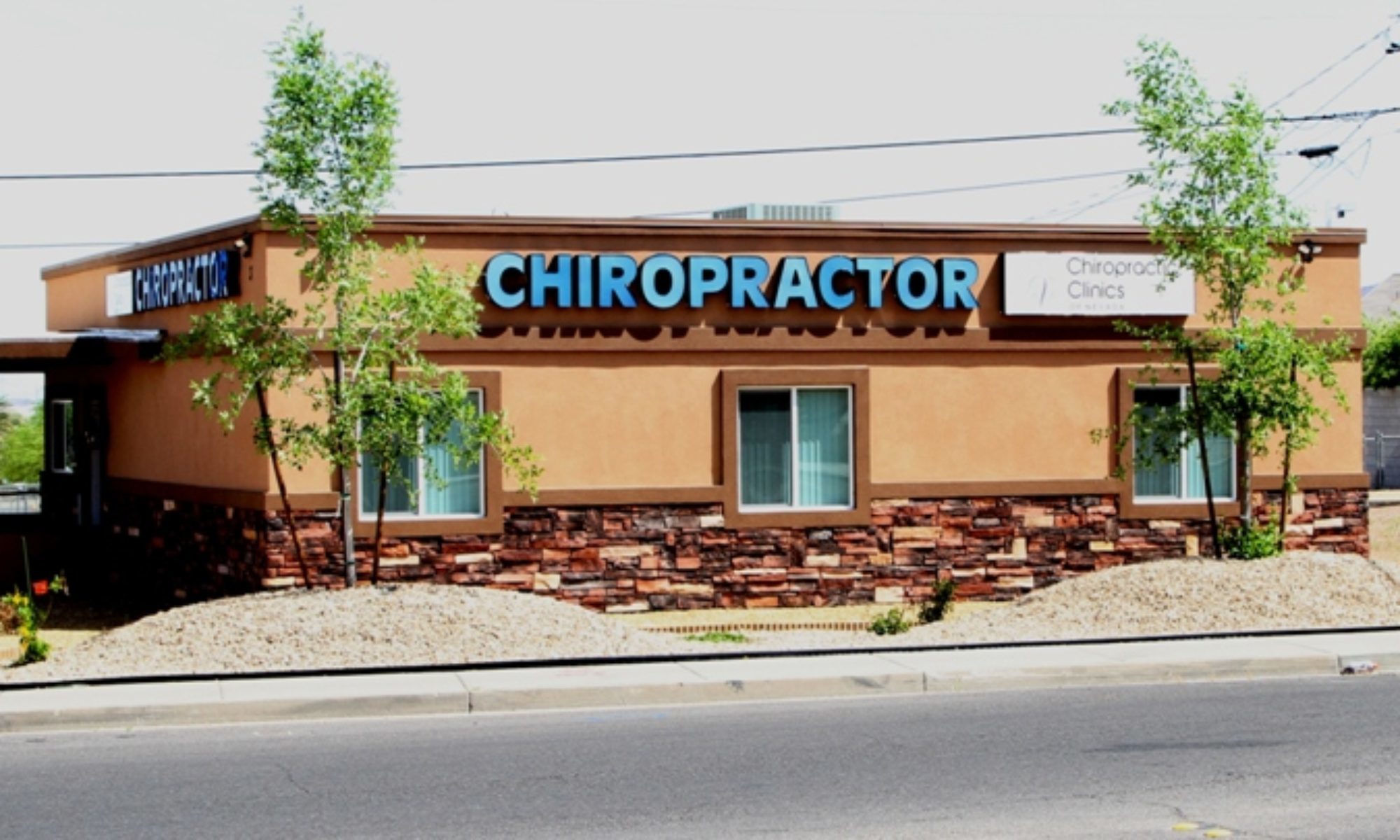Shoulder Pain: The Spinal Connection
Not surprisingly, shoulder pain can result from a bump, bruise or torn rotator cuff — a separation within the quadruple group of muscles encasing the shoulder joint. What may surprise you, however, is that misaligned cervical vertebrae (bones in the spine of the neck) can also spark shoulder pain.
The good news is that chiropractic care from Dr. Swolensky may help. An exciting large-scale review study shows that chiropractic care is effective in relieving shoulder pain. Read on to learn more.
The Spinal Connection
Click here to download ShoulderPain: The Spinal Connection 
There are seven cervical vertebrae, numbered C1 through C7. When these vertebrae become misaligned, the result is a condition known as vertebral subluxation. Nerves become trapped between the boney surfaces of the vertebrae: resulting in pain and/or
numbness. Misalignment of vertebrae also upsets the natural balance of surrounding muscles, tendons and ligaments.
Dysfunction related to the cervical spine leads to stressed muscles not only in the neck, but also in the entire shoulder girdle: also known as the pectoral girdle.
The primary function of the pectoral girdle is to provide an attachment point for the numerous muscles that allow the shoulders and elbow joints to move. When nerves become trapped — due to vertebral subluxation — muscles cease to function properly because they’re no longer getting their biomechanical instructions.
Don’t Guess at the Cause
Dr. Swolensky notes that proper diagnosis of shoulder pain is crucial. For instance, one study followed a 30-year-old female patient suffering from a combination of intense shoulder,
bicep and tricep pain — along with numbness in her thumb, index and middle fingers. Her family physician diagnosed the pain as tendonitis and told her to ice and “rest” the shoulder.
After three weeks of excruciating pain, she sought a second opinion and learned she had two herniated cervical discs: C6 and C7.
Physicians “need to understand diagnostic and treatment strategies for common causes of shoulder pain,” say researchers from the University of Wisconsin Medical School. They suggest that examination of the shoulder should include inspection, palpation
and evaluation of range of motion (ROM).
“In addition, a thorough sensorimotor [related to both sensory and motor activity] examination of the upper extremity should be performed, and the neck and elbow should be evaluated.”
(Am Fam Physician 2000;61:3079-88.)
Uncovering the Root Problem
Dr. Swolensky carefully examines patients for the underlying cause of shoulder ailments, including misalignments in the spine of the neck. “A thorough history and detailed physical examination will, in most cases, identify the cervical spine or the shoulder as the primary source of the disease,” say researchers (Clin Orthop Relat Res 1999;368:105-13).
Using safe, gentle maneuvers known as chiropractic adjustments, Dr. Swolensky realigns vertebrae: correcting the chain of events that may induce spine-related shoulder pain.
Chiropractic Relieves Shoulder Pain
A large review study reveals that there is a fair amount of evidence indicating that chiropractic adjustments alleviate shoulder pain.
As part of the analysis, researchers searched five major databases: 1) The Cumulative Index of Nursing Allied Health Literature; 2) PubMed; 3) The Manual, Alternative and Natural Therapy
Index System; 4) Physiotherapy Evidence Database; and 5) The Index to Chiropractic Literature.
Out of 211 studies found, 35 met the researchers’ strict inclusion criteria. After pooling the data, they concluded that there is fair evidence supporting the use of chiropractic adjustments for
shoulder disorders (J Manipulative Physiol Ther 2011;34:314-46).
Additional Research
Based on a study of 150 patients with shoulder pain, researchers in the Netherlands concluded that manipulative therapy of the pectoral girdle accelerates recovery of shoulder symptoms
(Ann Intern Med 2004;141:432-9).
Another group of researchers reached a similar conclusion. “A manual physical therapy approach addressing impairments of the cervical spine and upper limb neural tissue may lead to improved outcomes in the management of patients with shoulder pain
and disability.” (J Orthop Sports Phys Ther 2007;37:342-50.)
The SCM/SAN Link
The sternocleidomastoid (SCM) muscles — one on each side of the neck — allow you to turn your head and bend it forward. They also support your head as you get up from lying down. The spinal accessory nerve (SAN) connects the central nervous system with the SCM and trapezius muscles, which are responsible for severalactions, including shoulder elevation.
Studies show a distinctive link between shoulder pain and dysfunction of the SAN (Br J Oral Maxillofac Surg 2003;41:7-11).
Researchers theorize that vertebral subluxations in the spine may influence the health of this nerve.
Suprascapular Nerve
Entrapment of the suprascapular nerve is a “rare peripheral neuropathy, which can be easily overlooked in the differential diagnosis of shoulder pain and dysfunction. Entrapment can occur
at several different locations along the pathway of the nerve.” (Ortop
Traumatol Rehabil 2007;9:68-74.)
One of several nerves that originate in the neck, the suprascapular nerve — a union of the fifth and sixth cervical spine nerves — passes through a small groove-like opening in the scapula: the bone that forms the shoulder blade. The primary symptoms of suprascapular
nerve entrapment include pain, weakness and softening of the muscles.
Although rare, “accurate diagnosis facilitates appropriate and timely treatment.” (Ortop Traumatol Rehabil 2007;9:68-74.)
Posture and Shoulder Pain
Did you know that improper posture can also spark vertebral subluxations, neck and shoulder pain? For instance, keeping your neck straight and stiff can result in reduced ROM and a condition
known as “military neck.”
Hunching over a desk — whether at school, work or home — can similarly wreak havoc on your spine. Nerves become trapped, resulting in pain and weakness throughout the neck and upper extremities. Researchers in Finland tracked the posture and symptoms of 180 desk-bound employees (with no previously reported neck pain) for one year. By the year’s end, 34.4 percent had reported mild to severe neck pain (Occup Environ Med 2003;60:475).
Elevated arm postures are just as damaging. Case in point: A Swedish study that involved 235 orchestra musicians. The group was categorized into four exposure groups according to arm
position and duration of active playing time (ranging from two to three hours per workday). The researchers concluded that “Musicians working in an elevated arm position (e.g., violinists,
violists, flutists, and trumpet players) had a higher prevalence of neckshoulder pain than those working in a more neutral position.” (Am J Ind Med 2007;50:370-6.)
If you are a musician — or have a child who plays a musical instrument requiring extended arm elevation — talk to the doctor about ways to prevent repetitive shoulder, neck and spine injury.
Don’t Delay
Are you or a loved one suffering from shoulder pain? Even if it’s just an occasional “twinge,” make sure to schedule a chiropractic checkup.
Optimal Health University™ is a professional service of PreventiCare Publishing®. The information and recommendations
appearing on these pages are appropriate in most instances; but they are not a substitute for consultation with a health care provider. Optimal Health University™ may be photocopied (NOT reprinted) exactly as they are published noncommercially
by current subscribers ONLY to share with patients or potential patients. Optimal Health University™ may NOT be reprinted in any print or electronic publication including newsletters, newspapers, magazines or Web sites. Any other reproductions are subject to Preventi-Care Publishing® approval. Copyright, 2016. Preventi-
C a r e Pu b l i s h i n g ® . 1-831 – 3 1 3 – 0 3 3 5 .
www.preventicare.com
